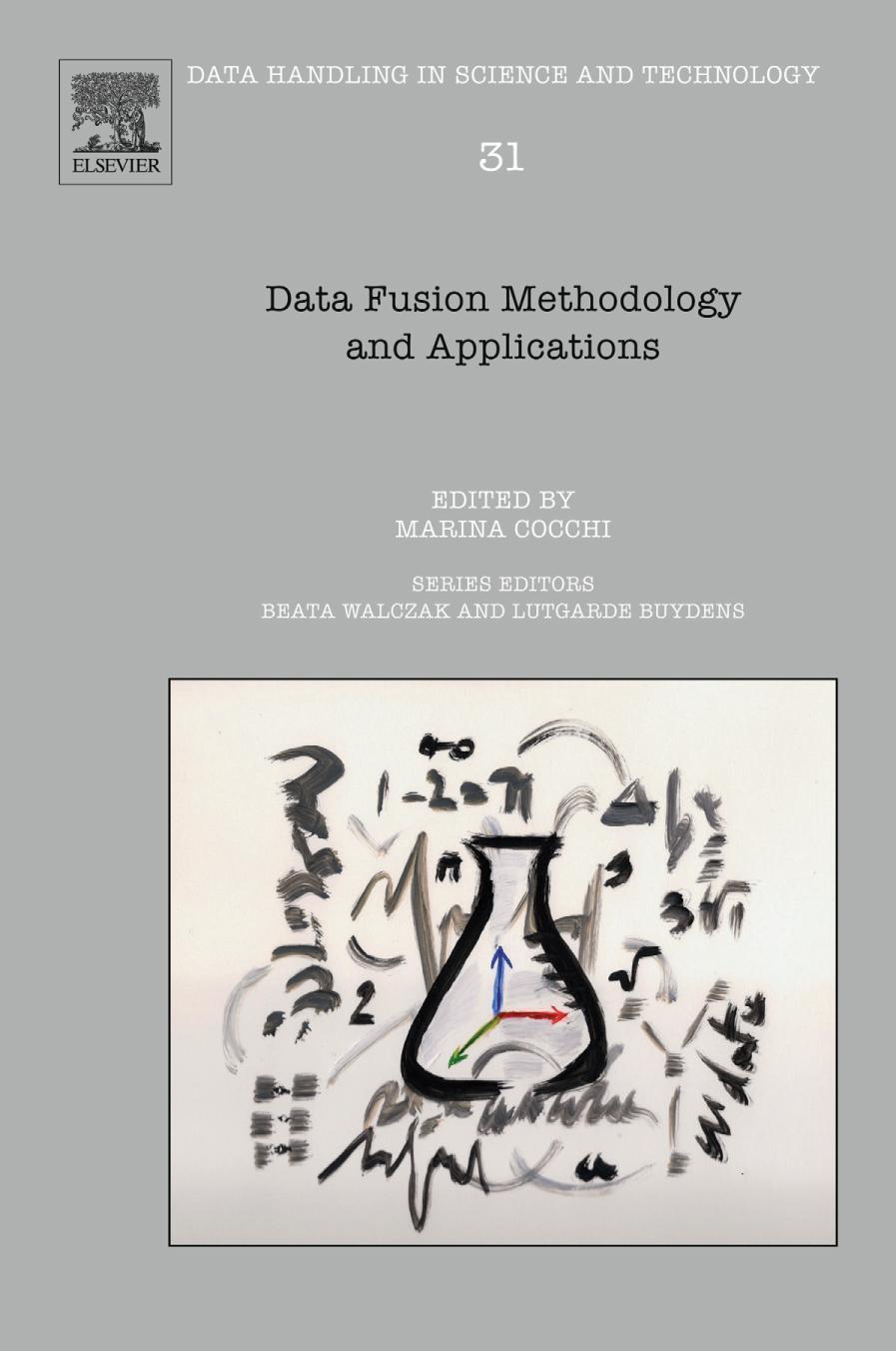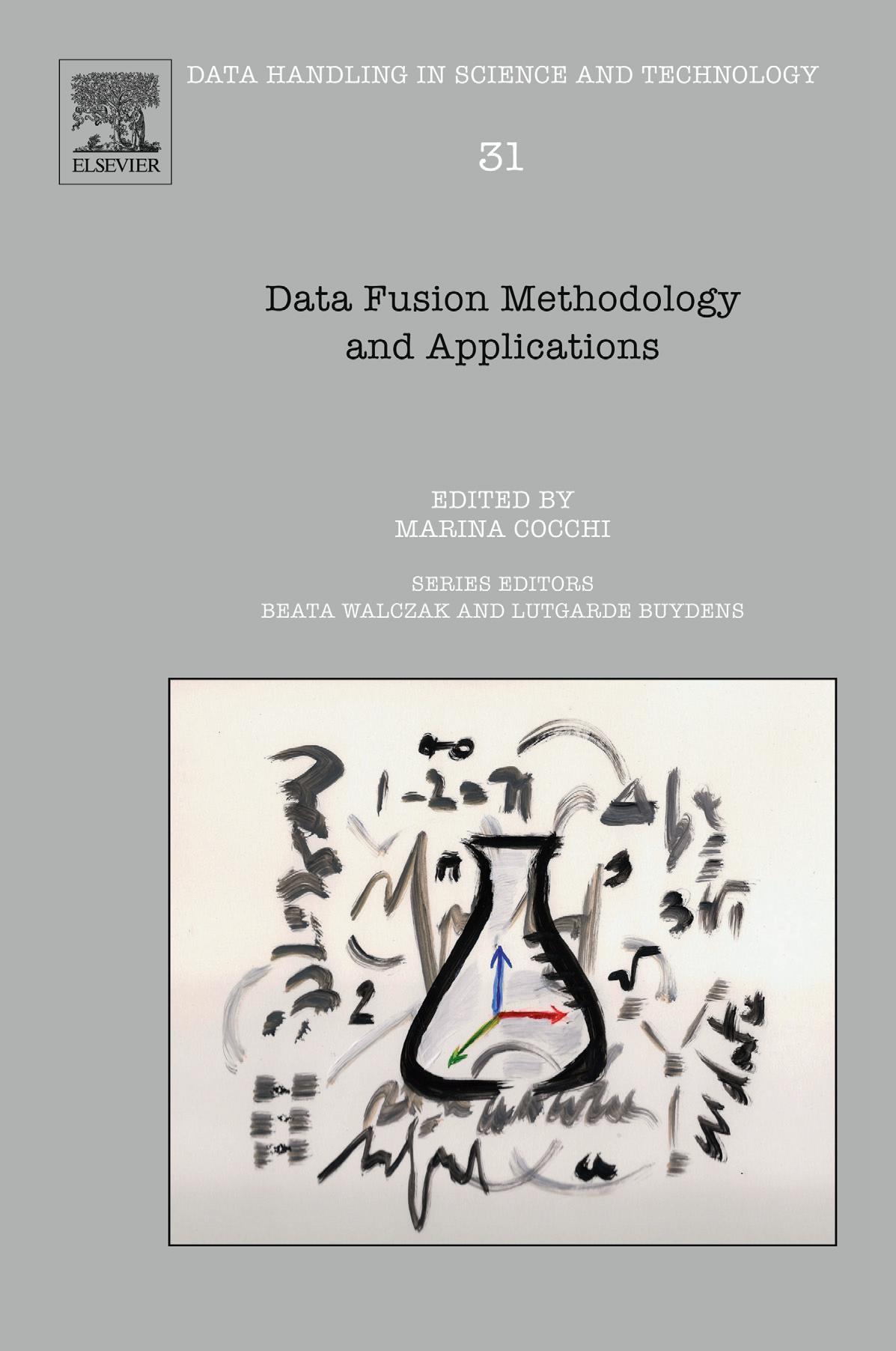Data Fusion Methodology and Applications
- eBook PDF
Visit to download the full and correct content document: https://ebooksecure.com/download/data-fusion-methodology-and-applications-ebookpdf/


Thispageintentionallyleftblank

Visit to download the full and correct content document: https://ebooksecure.com/download/data-fusion-methodology-and-applications-ebookpdf/


Thispageintentionallyleftblank
BEATAWALCZAK
LUTGARDEBUYDENS
Elsevier
Radarweg29,POBox211,1000AEAmsterdam,Netherlands
TheBoulevard,LangfordLane,Kidlington,OxfordOX51GB,UnitedKingdom 50HampshireStreet,5thFloor,Cambridge,MA02139,UnitedStates
Copyright © 2019ElsevierB.V.Allrightsreserved.
Nopartofthispublicationmaybereproducedortransmittedinanyformorbyanymeans, electronicormechanical,includingphotocopying,recording,oranyinformationstorageand retrievalsystem,withoutpermissioninwritingfromthePublisher.Detailsonhowtoseek permission,furtherinformationaboutthePublisher’spermissionspoliciesandourarrangements withorganizationssuchastheCopyrightClearanceCenterandtheCopyrightLicensingAgency,can befoundatourwebsite: www.elsevier.com/permissions
Thisbookandtheindividualcontributionscontainedinitareprotectedundercopyrightbythe Publisher(otherthanasmaybenotedherein).
Knowledgeandbestpracticeinthis fieldareconstantlychanging.Asnewresearchandexperience broadenourunderstanding,changesinresearchmethods,professionalpractices,ormedical treatmentmaybecomenecessary.
Practitionersandresearchersmustalwaysrelyontheirownexperienceandknowledgein evaluatingandusinganyinformation,methods,compounds,orexperimentsdescribedherein.In usingsuchinformationormethodstheyshouldbemindfuloftheirownsafetyandthesafetyof others,includingpartiesforwhomtheyhaveaprofessionalresponsibility.
Tothefullestextentofthelaw,neitherAACCInorthePublisher,northeauthors,contributors,or editors,assumeanyliabilityforanyinjuryand/ordamagetopersonsorpropertyasamatterof productsliability,negligenceorotherwise,orfromanyuseoroperationofanymethods, products,instructions,orideascontainedinthematerialherein.
LibraryofCongressCataloging-in-PublicationData
AcatalogrecordforthisbookisavailablefromtheLibraryofCongress
BritishLibraryCataloguing-in-PublicationData
AcataloguerecordforthisbookisavailablefromtheBritishLibrary
ISBN:978-0-444-63984-4
ISSN:0922-3487
ForinformationonallElsevierpublicationsvisitourwebsiteat https://www.elsevier.com/books-and-journals
Publisher: SusanDennis
AcquisitionEditor: KathrynMorrissey
EditorialProjectManager: LauraOkidi
ProductionProjectManager: PremKumarKaliamoorthi
CoverDesigner: ChristianBilbow
CoverDrawing: AnitaAccorsi
TypesetbyTNQTechnologies
Contributorsix Prefacexi
1.Introduction:WaysandMeanstoDealWithDataFrom MultipleSources
MARINACOCCHI
1.Motivation1
2.AFrameworkforLow-LevelDataFusion
AGEK.SMILDEANDIVENVANMECHELEN
1.IntroductionandMotivation27
3.GeneralFramingofLow-,Mid-,andHigh-LevelDataFusion WithExamplesintheLifeSciences
AGNIESZKASMOLINSKA,JASPERENGEL,EWASZYMANSKA,LUTGARDEBUYDENS,AND LIONELBLANCHET
1.Introduction51
2.DataSampling,Measurements,andPreprocessing54
3.DataFusionStrategy55
4.DataFusionStrategieswithExamples65
5.InterpretationoftheOutcomes72
6.Conclusions75 References76
4.NumericalOptimization-BasedAlgorithmsforDataFusion
N.VERVLIETANDL.DELATHAUWER
1.Introduction81
2.NumericalOptimizationforTensorDecompositions85
3.CanonicalPolyadicDecomposition91
4.ConstrainedDecompositions100
5.CoupledDecompositions111
6.Large-ScaleComputations117 References122
5.RecentAdvancesinHigh-LevelFusionMethodstoClassify MultipleAnalyticalChemicalData
D.BALLABIO,R.TODESCHINI,ANDV.CONSONNI
1.Introduction129
6.TheSequentialandOrthogonalizedPLSRegressionfor MultiblockRegression:Theory,Examples,andExtensions
ALESSANDRABIANCOLILLOANDTORMODNÆS
1.Introduction157
2.HowItStarted158
3.ModelandAlgorithm158
4.SomeMathematicalFormulaeandProperties160
5.HowtoChoosetheOptimalNumberofComponents161
6.HowtoInterprettheModels162
7.SomeFurtherPropertiesoftheSO-PLSMethod163
8.ExamplesofStandardSO-PLSRegression165
9.ExtensionsandModificationsofSO-PLS167
10.Conclusions175 References176
7.ComDimMethodsfortheAnalysisofMultiblock DatainaDataFusionPerspective V.CARIOU,D.JOUAN-RIMBAUDBOUVERESSE,E.M.QANNARI,ANDD.N.RUTLEDGE
1.Introduction179
2.ComDimAnalysis181
3.P-ComDimAnalysis185
4.Path-ComDimAnalysis189
5.Software191
6.Illustration191
7.Conclusion202 References202
8.DataFusionbyMultivariateCurveResolution
ANNADEJUANANDR.TAULER
1.Introduction.GeneralMultivariateCurveResolutionFramework. WhytoUseItinDataFusion?205
2.DataFusionStructuresinMCR.MultisetAnalysis208
3.ConstraintsinMCR.VersatilityLinkedtoDataFusion. HybridModels(Hard Soft,Bilinear/Multilinear)211
4.LimitationsOvercomebyMultisetMCRAnalysis.BreakingRankDeficiency andDecreasingAmbiguity218
5.AdditionalOutcomesofMCRMultisetAnalysis.TheHiddenDimensions221
6.DataFusionFields222
7.Conclusions227 References228
9.DealingWithDataHeterogeneityinaDataFusionPerspective:
Models,Methodologies,andAlgorithms
FEDERICAMANDREOLIANDMANUELAMONTANGERO
1.Introduction235
2.OverviewofLifeScienceDataSources237
3.AddressingDataHeterogeneity239
4.LatestTrendsandChallenges255
5.Conclusions264 References265
10.DataFusionStrategiesinFoodAnalysis
ALESSANDRABIANCOLILLO,RICARDBOQUE ´ ,MARINACOCCHI,ANDFEDERICOMARINI
1.Introduction271
2.ChemometricStrategiesAppliedinDataFusion273
3.Building,Optimization,andValidationofData-FusedModels276
4.Applications278
5.Conclusions301 References301
11.ImageFusion
ANNADEJUAN,AOIFEGOWEN,LUDOVICDUPONCHEL,ANDCYRILRUCKEBUSCH
1.Introduction311
2.ImageFusionbyUsingSingleFusedDataStructures314
3.ImageFusionbyConnectingDifferentImagesThroughRegressionModels323
Detection,Classification,andImageLibrarySearching JOHNH.KALIVAS
D.Ballabio MilanoChemometricsandQSARResearchGroup,Departmentof EarthandEnvironmentalSciences,UniversityofMilanoBicocca,Milano,Italy
AlessandraBiancolillo DepartmentofChemistry,UniversityofRome“La Sapienza”Rome,Italy
LionelBlanchet
DepartmentofPharmacologyandToxicology,NUTRIMSchool forNutrition,andTranslationalResearchinMetabolism,MaastrichtUniversity, Maastricht,TheNetherlands
RicardBoque ´ UniversitatRoviraiVirgili,DepartmentofAnalyticalChemistry andOrganicChemistry,CampusSesceladesTarragona,Spain
LutgardeBuydens RadboudUniversity,InstituteforMoleculesandMaterials, DepartmentofAnalyticalChemistry,Nijmegen,TheNetherlands
V.Cariou StatSC,ONIRIS,INRA,Nantes,France
MarinaCocchi DepartmentofChemicalandGeologicalSciences,Universityof ModenaandReggioEmilia,Modena,Italy
V.Consonni MilanoChemometricsandQSARResearchGroup,Departmentof EarthandEnvironmentalSciences,UniversityofMilanoBicocca,Milano,Italy
AnnadeJuan ChemometricsGroup,Dept.ofChemicalEngineeringand AnalyticalChemistry,UniversitatdeBarcelona,Barcelona,Spain
L.DeLathauwer KULeuven,DepartmentofElectricalEngineeringESAT/ STADIUS,KasteelparkArenberg,Leuven,Belgium;GroupScience, EngineeringandTechnology,KULeuven-Kulak,Kortrijk,Belgium
LudovicDuponchel Universite ´ deLilleLASIR,Lille,France
JasperEngel Biometris,WageningenUniversityandResearch,Wageningen, TheNetherlands
AoifeGowen
SchoolofBiosystemsandFoodEngineering,UniversityCollege Dublin,Dublin,Ireland
D.Jouan-RimbaudBouveresse UMRInge ´ nierieProce ´ de ´ sAliments, AgroParisTech,Inra,Universite ´ Paris-Saclay,Massy,France;UMRPNCA, AgroParisTech,INRA,Universite ´ ParisSaclay,Paris,France
JohnH.Kalivas
DepartmentofChemistry,IdahoStateUniversity,Pocatello,ID, UnitedStates
FedericaMandreoli Dip.diScienzeFisiche,InformaticheeMatematiche, Modena,Italy
FedericoMarini
DepartmentofChemistry,UniversityofRome“LaSapienza” Rome,Italy
ManuelaMontangero Dip.diScienzeFisiche,InformaticheeMatematiche, Modena,Italy
TormodNæs NofimaAS,Aas,Norway;QualityandTechnology,Department ofFoodScience,FacultyofLifeSciences,UniversityofCopenhagen, Frederiksberg,Denmark
E.M.Qannari StatSC,ONIRIS,INRA,Nantes,France
CyrilRuckebusch Universite ´ deLilleLASIR,Lille,France
D.N.Rutledge UMRInge ´ nierieProce ´ de ´ sAliments,AgroParisTech,Inra, Universite ´ Paris-Saclay,Massy,France
AgeK.Smilde BiosystemsDataAnalysis,SwammerdamInstituteforLife Sciences,UniversityofAmsterdam,Amsterdam,TheNetherlands
AgnieszkaSmolinska DepartmentofPharmacologyandToxicology,NUTRIM SchoolforNutrition,andTranslationalResearchinMetabolism,Maastricht University,Maastricht,TheNetherlands
EwaSzymanska FrieslandCampina,Amersfoort,TheNetherlands
R.Tauler IDAEA-CSIC,Barcelona,Spain
R.Todeschini MilanoChemometricsandQSARResearchGroup,Departmentof EarthandEnvironmentalSciences,UniversityofMilanoBicocca,Milano,Italy
IvenVanMechelen ResearchGrouponQuantitativePsychologyandIndividual Differences,KULeuven,Leuven,Belgium
N.Vervliet KULeuven,DepartmentofElectricalEngineeringESAT/STADIUS, KasteelparkArenberg,Leuven,Belgium
Thisbookdealswithdatafusionaimingatfurnishingavisionofthe differentavailablemethodologiesandthedataanalyticschallenges,framingatthesametimethenatureofcoupleddataandhowdatafusioncan enhanceknowledgediscovery.Tothisaim,thisbookwillalsofocuson methodsthatallowunravellingcommonanddistinctinformationfrom differentblocksofdata.
Theadoptionofdata-drivendiscoveryparadigminsciencehasledto theneedofhandlinglargeamountofdiversedata.Driversofthischange areononehandtheincreasedavailabilityandaccessibilityofhyphenated analyticalplatform,imagingtechniques,theexplosionofomicsdata,and ontheotherhandthedevelopmentofinformationtechnology.Hence,the mainchallengeishowtofacethesemultiplesourcedataandhowto retrieveallpossibleavailableinformation.Oneofthesalientaspectsis themethodologytointegratedatafrommultiplesources,analyticalplatforms,differentmodalities,varyingtimescale,aswellasunstructured data.Thisisgenerallyreferredtoasdatafusion.
Datafusionisforsureahotissue,aswellasamultifacetedconcept, and,asitemergesfromliterature,inrecentyearstherehasbeenaprogressivedevelopmentofawealthofmethods.However,themainattitudehas been,withfewexception,topresent/discussspecifictoolsconfinedina givendisciplineorcontext,especiallywithinthefieldofmonographs thefocuswasmostlyposedonremotesensingandmultisensordata integration.Aunifiedviewisstilllacking,whichpreventsauseful contaminationacrossdisciplines,awiderunderstandingandproperdisseminationofthemethodology.
Thisbookhastheambitiontoaddresstheseissues,providingacomprehensiveandcomprehensibledescriptionofthecurrentstateofthe artandofferingacross-disciplinaryapproachandaknowledgeretrieval basedperspectivetogetherwithpresentingchallengingandconvincing applications.
Thisbookismultiauthoredandwrittenasacollectionofindependent chaptersthatprovidedifferentperspectivesandapplications.However, whenconsideredaltogether,thechaptersintegrate,givingsoundbasis tounderstandthedatafusionprocess.
Thefirstfivechapterscoverthebasicconceptsandthemainmethodologies.Introductiondetailswaysandmeanstoaccomplishdatafusion andtherelatedtaxonomiesframingtheminauser’sperspective.
AltogetherChapters2,3,and5provideageneralframeworkforlow-, mid-,andhigh-leveldatafusionmethodologiesincludingmotivating applicationsinlifescienceandanalyticalchemistry;inparticular,Chapter 2presentsagenericmodelforcoupleddatablocksaimedatrecovering fullinformationineachsingledatablock,aswellastheircommon,distinctiveinformationandthelinkingrelations.Chapter4presentsavery generalandflexiblemathematicalframework,whichallowsmatrices and/ortensorstobecoupledthrough(partially)sharedfactorsor throughcommonunderlyingvariables,addressingaswelltechniques suitabletohandlebigdata.
Chapters6,7,and8illustrate,inatutorialmanner,multiblockandmultisetmethodsintheperspectiveofdatafusion,showingthespecificities andlinkamongtheseapproaches.
Thelastfourchapters(Chapters9 12)aremoreorientedtowardapplications,suchasfoodcharacterizationandauthenticity(Chapter10), imageanalysis(Chapter11),and/orspecificambitsasChapter12,which presentan“ensemble”approachtodatafusionwithapplicationstooutlierdetection,classification,andimagelibrarysearching,andChapter9 whichillustratesthechallenges,andpossiblesolutionfromcomputerscience,indealingwithdataheterogeneity,e.g.,infusionofsemanticdatain lifesciencedomain.
Aconspicuousefforthasalsobeendevotedtopresentanextensivebibliographywhichisnonethelessincomplete,whenconsideringtheamount ofscientificliteratureonthesubject,butcouldserveasagoodlisttoface thesubject.
Writtenbyinvitedauthorswhoarerecognizedexpertsintheirfield, thisbookisaddressedtograduatestudents,researchers,andpractitioners;chaptersarewritteninawaytobeunderstandabletolargeand diverseaudienceandcontainenoughinformationtobe,byitself,sufficientandtobereadindependentlyoftheotherchapters.
Whatthereaderwouldfindisputtingdatafusionincontextandperspective,amultidisciplinaryview,detailedmethodsdescription,and challengingapplications.
Finally,Iwouldliketoexpressmysinceregratitudetoalltheinvited authorswhohaveacceptedtocooperateandcontributedtothisbook, aswellasmyapologiesforthedelayanddifficultiessomehowencountered.Ialsowishtothanktheseveralpeoplewho,onewayoranother, supportedthisproject.
Theinterestindataintegrationorfusionhasgainedrenewedattention inrecentyearsowingtoboththecontinuousdevelopmentofinstrumental techniquesandsensordevicesandaparadigmchangeinthestudyof complexsystemstowardholistic,data-drivenapproaches [1,2].Ontheone hand,thetechnologicaldevelopmentininstrumentationhasincreasedthe dataacquisitionspeed,thecouplingofdifferentinstrumentalmodalities (hyphenation),theirportability(insitu,on/in-line),andthedatastorage capacity,thusleadingtoanenormousgrowthofavailabledatafor analysis;ontheotherhand,theparadigmshiftreliesondata-intensive statisticalexplorationanddataminingforknowledgediscovery.
Theneedfordataintegrationisthusbecomingubiquitousand encompassesseveraldifferentdisciplines.Roughlysummarizing,three mainareas,whichalsoidentifythemainreferencecommunities(listed distinctlyforbrevity,but,however,nottobeintendedasexclusive),can beevidenced:multisensors/remotesensing [3,4] (engineering,geoscience,signalprocessing),internetofthings/bigdata [5,6] (informatics, machinelearning,computerscience),andjointanalysisofmultipledata setsacquiredbydifferentmodalities(differenttypesofinstruments, experiments,andsettings) [7] (chemometrics,psychometrics,applied mathematics).
DataFusionMethodologyandApplications
https://doi.org/10.1016/B978-0-444-63984-4.00001-6